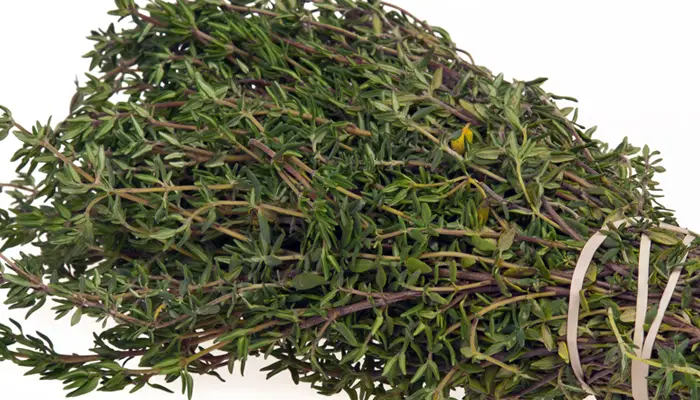Thyme is a versatile herb that can be used in many different dishes. While it’s always best to use fresh thyme, there are times when a substitute is necessary. If you’re looking for a thyme substitute, you’re in luck! This blog post will teach you about the different flavors that can enhance your meals.
1. Oregano
One of the most popular thyme substitutes is oregano. This herb has a strong flavor, so it’s best used in small amounts. When substituting oregano for thyme, use half as much as you would thyme. Oregano goes well with many different dishes, so it’s a great all-purpose herb to keep on hand.
Oregano is a perennial herb that grows in dry, rocky areas. The plant has large leaves and white, pink or purple flowers.
It’s a member of the mint family and is related to marjoram, basil and thyme. It has a pungent flavor that’s slightly bitter, hot and peppery.
Oregano can be used fresh in sauces, soups, stews and other dishes or dried in seasoning blends to add flavor to foods like pizza or pasta dishes.
Dried oregano is available ground or as whole leaves that can be crumbled into dishes before serving or added during cooking time (fresh oregano may lose its flavor quickly). Fresh oregano should be stored in the refrigerator after being purchased; it may also be frozen for long-term storage.
2. Basil
Another thyme substitute is basil. This herb has a sweet, yet slightly peppery flavor that can enhance any dish. When substituting basil for thyme, use half as much as you would thyme. Basil goes well with tomato-based dishes, so it’s a great choice for Italian recipes.
Basil is a warm, sweet herb that can be used fresh or dried. Basil has been cultivated for over 5,000 years and has more than 80 varieties. It is native to India but grows well in warm climates. Basil is a tender plant that needs to be grown indoors during the winter months and kept warm.
Basil is an annual plant (it must be replanted each year), but it can grow up to 1 foot tall if given proper care and sunlight. The leaves of the basil plant have a strong aroma and taste like a cross between mint and oregano.
3. Marjoram

Marjoram is a perennial herb with sweet, delicate flavor. It’s a member of the mint family and has a similar aroma, but it has a softer flavor than oregano.
Marjoram has been used in cooking since ancient times and was considered sacred by the ancient Greeks, who called it “joy of the mountain.” The name comes from the Latin words majorum, which means “large” or “bigger,” and majuscula, meaning “little” or “tending toward the big.”
The leaves are dark green and oval-shaped with an intense aroma and flavor. They can be used fresh or dried for long-term storage.
Marjoram is native to southern Europe and North Africa but is now grown all over the world. It’s also known as knotted marjoram because its leaves are tied together into small bundles before drying to keep them from losing their aromatic oils during storage.
4. Rosemary
Rosemary is a popular herb that has been used for thousands of years. It’s easy to grow, smells great and has many uses in the kitchen.
Rosemary is a perennial shrub that grows up to 4 feet tall and wide. It has gray-green leaves that are needle-like and aromatic when crushed. There are several varieties of rosemary including needlepoint, prostrate and creeping. The most common variety is Rosmarinus officinalis which grows in U.S. Department of Agriculture plant hardiness zones 7 through 10.
What does Rosemary taste like?
Rosemary tastes like pine needles with a hint of minty sweetness, which makes it an excellent herb for cooking meat dishes or for making vinegars and oils for seasoning food at the table.
5. Savory
Savory is a herbaceous perennial that is native to Asia, but has been used in European cooking for centuries. It’s also known as summer savory, garden savory and winter savory. The plant produces dark green, feathery leaves that have a very distinctive flavor. The leaves are used fresh or dried in cooking.
The flavor of savory falls somewhere between thyme and mint, with hints of lemon and pine. It’s often used to season meats such as pork, chicken or beef. It can also be added to soups, stews and casseroles.
What Does Savory Taste Like?
Savory has a distinct flavor that combines elements from thyme and mint with a hint of lemon or pine. It’s often described as having an “earthy” taste because it contains phenolic compounds like eugenol and methyl chavicol (which are similar to clove). The herb’s aroma comes from these compounds as well as others like 1-octen-3-ol (which smells like horse sweat). This makes it an unusual herb with a unique scent that can be off-putting to some people.

These are all great thyme substitutes, but my personal favorites are savory, marjoram, or oregano. Having a full spice cabinet is always a good idea so you can experiment with different flavors and find what you like best.